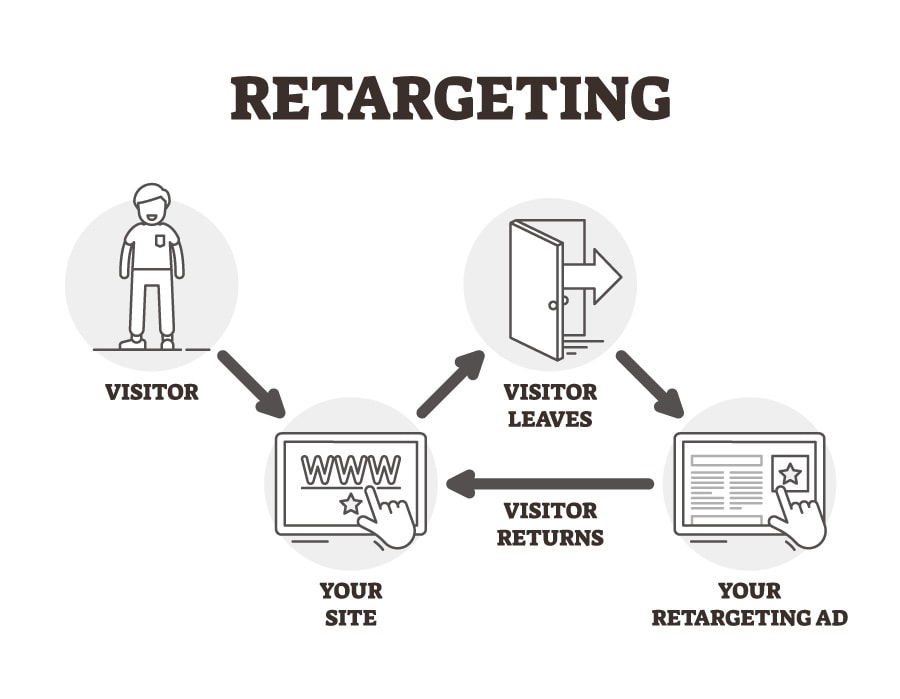In this spectral season, don’t let the notion of initiating a new business venture send shivers down your spine! Every remarkable journey begins with a single step, and there’s no time more opportune than the present.
Our newsletter for October is laden with invaluable advice and cunning strategies tailored for business owners, regardless of whether you are venturing into your first business or are a seasoned entrepreneur. Immerse yourself in our curated content and unearth the secrets to selecting an adept online business coach, orchestrating successful retargeting campaigns, and a plethora of additional insights!
Warmest Wishes,
Daniel Dias


Navigating the Path to the Right Online Business Coach
Launching and maintaining a successful business is undoubtedly a formidable endeavor.
To navigate through various business phases, adopting distinct approaches, strategies, and resources is crucial. However, the journey can be fraught with potentially expensive mistakes, some of which can be detrimental to the business itself, without proper guidance from an experienced and knowledgeable individual.
An online business coach serves as this guiding figure, assisting you in achieving your goals with precision and helping your business grow expeditiously under their adept guidance.
Role of an Online Business Coach:
An online business coach, often a self-employed expert, provides crucial advice to achieve your business aspirations. Acting as a mentor, life coach, and sounding board, they assist in the development and successful execution of your business plan and strategies, managing operational stress, and improving sales.
This comprehensive mentorship enables the growth of your business, minimizing errors and optimizing results. It is no wonder that one in six entrepreneurs seek such coaching to enhance their business performance.
Online vs. In-Person Coaching:
While the benefits of having a business coach are manifold, it’s vital to discern between online and in-person coaching. Both formats can be delivered one-on-one or in groups. However, online coaching, facilitated by video conferencing technologies, is gaining traction due to its convenience and cost-effectiveness.
Studies indicate no substantial difference in effectiveness between the two modes, with the quality and experience of the coach and the motivation of the client being the determining factors. However, attention should be paid to the contractual clauses related to confidentiality and client obligations in online coaching.
Benefits of Online Business Coaching:
A proficient business coach aids in:
Developing foundational business elements
Conducting insightful market research
Effectuating marketing strategies
Overcoming challenges related to client relations and operations
Streamlining business operations
Identifying and capitalizing on new opportunities
By providing personalized support, an online business coach can guide you through any business development stage, as long as you are receptive to identifying and addressing your areas of improvement.
Selecting the Right Business Coach:
While choosing a coach, it’s pivotal to assess their industry experience, expertise, client reviews, and their approach. A preliminary consultation can offer insights into whether the coach aligns with your needs and personality. Once a coach is selected, goal setting, diligent work, and negotiations regarding fees, which can vary, are key steps.
Several online platforms and organizations offer commendable business coaching services, like Coachfirm, Building Champions, Vanguard Business Coaching, and Melinda Emerson, providing both in-person and online services.
Conclusion:
Engaging with a suitable online business coach can illuminate your path, helping you avert pitfalls and grasp new opportunities, eventually propelling your business to new heights in minimal time.

Understanding Retargeting Campaigns
Definition and Importance:
Retargeting Campaigns are a specialized advertising strategy focusing on re-engaging consumers who visited a site but didn’t make a purchase. It’s vital as it strategically positions your brand in front of an audience that has already expressed interest, optimizing advertising costs and enhancing conversion probabilities.
Key Benefits:
- Cost-Efficiency: Targets an already interested audience, making it more budget-friendly.
- Enhanced Conversions: Increases the likelihood of converting previous visitors.
- Brand Familiarity: Due to the mere exposure effect, repetitive viewing can foster brand recognition and affinity.
- Customer Lifetime Value: Encourages repeat purchases from existing customers.
- Reduced Cart Abandonment: Reminds customers of their incomplete purchases.
Types of Retargeting:
- Pixel-Based: Utilizes a JavaScript pixel to anonymously track users’ browsers, enabling the display of retargeted ads on various platforms.
- List-Based: Uses uploaded email lists to display targeted ads on social platforms like Facebook.
Implementing Retargeting Campaigns
Initial Steps:
- Define Goals: Identify whether the aim is to spread awareness, drive conversions, or increase a customer’s lifetime value.
- Platform Selection: Choose suitable platforms or tools like Google AdWords, Facebook, AdRoll, or SharpSpring Ads based on your target audience and goals.
Execution on Google AdWords:
- Create a new campaign and select desired results and parameters, including campaign name, location, language, and budget.
- In the ‘People’ section, select ‘Audiences’, click on ‘Remarketing’, and choose the desired audiences.
- Save and monitor your campaign’s progress and gather cookies through the ‘All Visitors’ list.
Execution on Facebook:
- Set an ad campaign and define your audience set, ensuring the toggle switch indicates it’s a retargeting campaign in the ‘Ad Manager’.
- Upload your list to Facebook’s ‘Audience Manager’ and set your Destination URL, budget, and segment your ads.
- Regularly track and analyze your campaign’s progress.
Evaluating Success:
Irrespective of the chosen platform, detailed reports on actions taken, engagement levels, and overall success should be regularly reviewed and assessed. Repeated tweaking and testing of various approaches are crucial until a successful formula is found, upon which it can be replicated to achieve all retargeting goals.
Conclusion:
Retargeting campaigns are indispensable in modern digital marketing. They provide an efficient way to stay connected with an interested audience, optimizing advertising ROI, fostering brand affinity, and maximizing conversion opportunities. Regular analysis and continuous optimization are key to leveraging retargeting campaigns for sustainable business growth.

Step-by-Step Guide to Forming Your LLC
Starting an LLC (Limited Liability Company) involves several steps, and the process can vary slightly depending on your location. Here’s a general guideline to help you form an LLC.
1. Choose a Name for Your LLC:
- Your LLC’s name must be distinguishable from other businesses and must end with an LLC designator like “Limited Liability Company” or “LLC.”
- Check the availability of your desired name through your state’s business registration office, usually the Secretary of State’s office.
2. Choose a Registered Agent:
- Select a registered agent, an individual, or a business entity authorized to receive legal papers on behalf of your LLC.
3. File Articles of Organization:
- File the Articles of Organization with your state’s business registration office and pay the filing fee, which varies by state.
- This document typically includes the LLC’s name, its purpose, and information about the registered agent and members.
4. Create an Operating Agreement:
- Draft an operating agreement to outline the ownership structure, member roles, and operating procedures of your LLC.
- While not always legally required, it’s crucial for clarifying business operations and member responsibilities.
5. Obtain an EIN:
- Apply for an Employer Identification Number (EIN) from the IRS, which is necessary for tax purposes.
- You can apply online for free at the IRS website.
6. Set Up a Business Bank Account:
- Open a business checking account in the name of your LLC to keep personal and business finances separate.
7. Register for State and Local Taxes:
- Register with the appropriate state and local agencies to obtain necessary tax identification numbers and pay sales, income, and employment taxes.
- Requirements vary by state and the nature of your business.
8. Obtain Business Licenses and Permits:
- Research and acquire any licenses or permits that are required to operate your business legally, based on your business activities and location.
9. Comply with Employee Regulations:
- If you have employees, ensure that you follow state and federal regulations regarding employee rights, wages, and workplace safety.
10. Maintain Compliance:
- Maintain your LLC by filing any required annual reports and paying the necessary renewal fees.
- Stay informed about any changes in state laws or regulations affecting LLCs to ensure ongoing compliance.
Additional Considerations:
- Business Insurance: Consider obtaining business insurance to protect against unforeseen risks and liabilities.
- Professional Advice: Consult with a business attorney or a professional advisor to ensure that you comply with all legal and regulatory requirements, and to receive advice tailored to your specific business needs.
Remember, the specific requirements and fees can vary, so it’s crucial to check with your state’s business registration office or the Secretary of State’s office for the most accurate and up-to-date information.

Navigating Retail Strategies: Omnichannel vs. Multichannel Retailing for Your Business
In the evolving landscape of retail, brands often find themselves debating between two prevalent approaches: multichannel and omnichannel retailing. While the concepts might seem synonymous, they have distinct differences that can significantly impact the customer experience and overall business operations.
Understanding Multichannel Retail
Multichannel retail revolves around selling products through various channels, be it digital, physical, or a mix of both. For instance, a brand utilizing a physical store, a website, and Amazon exemplifies multichannel retailing. However, the distinctive characteristic of multichannel retail is the lack of interconnection between these channels.
Consider a scenario where a customer, intrigued by a product on a company’s website, visits the local store to make a purchase but finds the item out of stock. This scenario highlights the disconnection between the channels, resulting in a disjointed customer experience.
The Omnichannel Retail Experience
Omnichannel retail also utilizes multiple selling platforms but offers a seamless, integrated experience for customers. In an omnichannel approach, every sales channel is interconnected, providing real-time data and consistent experiences.
Take the example of a customer who visits a website practicing omnichannel retail, finds the desired product in stock at a local store, adds it to their wish list, and then purchases it in-store with the assistance of a sales rep accessing their wish list. This illustrates the seamless integration of channels in omnichannel retail.
Comparing Multichannel and Omnichannel Retail
The dichotomy between multichannel and omnichannel retail becomes clear once their operational methodologies are understood. Multichannel retail provides diverse content through different channels without integration, focusing more on product proliferation than customer experience.
Conversely, omnichannel retail strives for customer-centric experiences by interweaving online and in-store operations, allowing customers to interact with the brand through various touchpoints seamlessly. Omnichannel strategies prioritize customer experience by employing integrated sales and marketing activities, analytics, and a central data hub, albeit at a higher cost compared to multichannel retail.
Implementing Omnichannel Retail
Platforms like BigCommerce, Shopify, and Webgility offer robust solutions for brands looking to embrace omnichannel retailing. However, implementing omnichannel strategies involves considerations regarding integration costs, transaction volumes, software, seller fees, storage expenses, and payment processing fees.
Determining the Right Approach for Your Business
For businesses reluctant to incur additional costs and those with custom POS systems or commission-based sales representatives, multichannel retailing might be more suitable. It allows for sales across different channels without the necessity for costly integrations.
On the other hand, omnichannel retailing can be exceptionally beneficial for local businesses with eCommerce stores, companies with loyalty programs, and those utilizing email newsletters, as it ensures seamless customer experiences and targeted engagements. However, it’s crucial for businesses dealing with products with larger margins to consider the cost implications associated with omnichannel selling.
Conclusion
Both multichannel and omnichannel retailing can offer advantages depending on your business model, industry, and specific circumstances. Evaluating the unique needs, customer expectations, and resources of your business is crucial in determining the most suitable approach to maximize customer satisfaction and optimize operational efficiency.

9 Proven Strategies to Secure Authentic YouTube Subscribers:
Encourage Viewers to Subscribe:
Politely prompt viewers to subscribe at the conclusion of your videos. A gentle reminder can go a long way without seeming overly aggressive.
Cultivate a Sense of Community:
By actively engaging in discussions, responding to comments, and understanding your audience’s preferences, you can build a connected community around your content.
Enhance Visibility with Optimized Titles and Descriptions:
Compose engaging, succinct titles incorporating relevant keywords and furnish coherent, concise descriptions to augment visibility and optimize Click Through Rate (CTR).
Adhere to a Regular Upload Routine:
Maintaining a steady and frequent upload cadence is pivotal in holding onto subscribers.
Produce Top-Notch, Captivating Content:
Strategically create content that is both insightful and entertaining, concentrating on a specific niche. Structure your content effectively with a hook, introduction, main body, and Call-To-Action (CTA).
Prioritize Channel Branding:
Establish a solid brand identity with a visually appealing banner, consistent channel icon, compelling channel description, custom URL, and cohesive thumbnails.
Implement Subscription-Inducing Features:
Employ features like YouTube’s End Screen and brand watermark to simplify the subscription process for your viewers.
Host Engaging Contests and Giveaways:
Incentivize subscriptions and interactions across platforms by organizing contests with attractive rewards, leveraging platforms like Easypromos, Gleam, and Wishpond.
Extend Your Reach Through Cross-Promotion:
Diversify your promotional efforts by sharing your videos on various social media platforms, forging collaborations with influencers, and integrating your YouTube channel link in your email signatures.
The Significance of Authentic Subscribers:
Genuine subscribers significantly contribute to organic reach, interaction levels, content sharing, and view rates.
In contrast, acquiring subscribers can result in unsustainable growth marked by non-engaging bots, potential reputation damage, and infringement of YouTube’s guidelines.
Conclusion:
Attaining enduring success on YouTube necessitates a focus on accumulating authentic subscribers. By embracing these proven strategies, creators can stimulate genuine interactions, broaden their audience, and refine their digital video marketing endeavors effectively.
Business Credit Lines

👔 Are you a business owner boasting a credit score of 700 or higher? If so, we have fantastic news for you!
💰 We specialize in securing approvals for LLCs like yours, guaranteeing funding ranging from $50,000 to $150,000, all at a remarkable 0% interest rate.
💬 Ready to take the next step? Click here to schedule a call.

About the Author: Daniel Dias is a Business Lending Specialist who assists small business owners in obtaining the capital they need to start, expand, or maintain their businesses. Daniel understands the challenges faced by entrepreneurs and offers a variety of programs with flexible guidelines to help overcome common obstacles such as credit scores, credit history, time in business, financial documentation, and industry type. His expertise enables business owners to secure the necessary funding to achieve their goals and succeed in the marketplace.